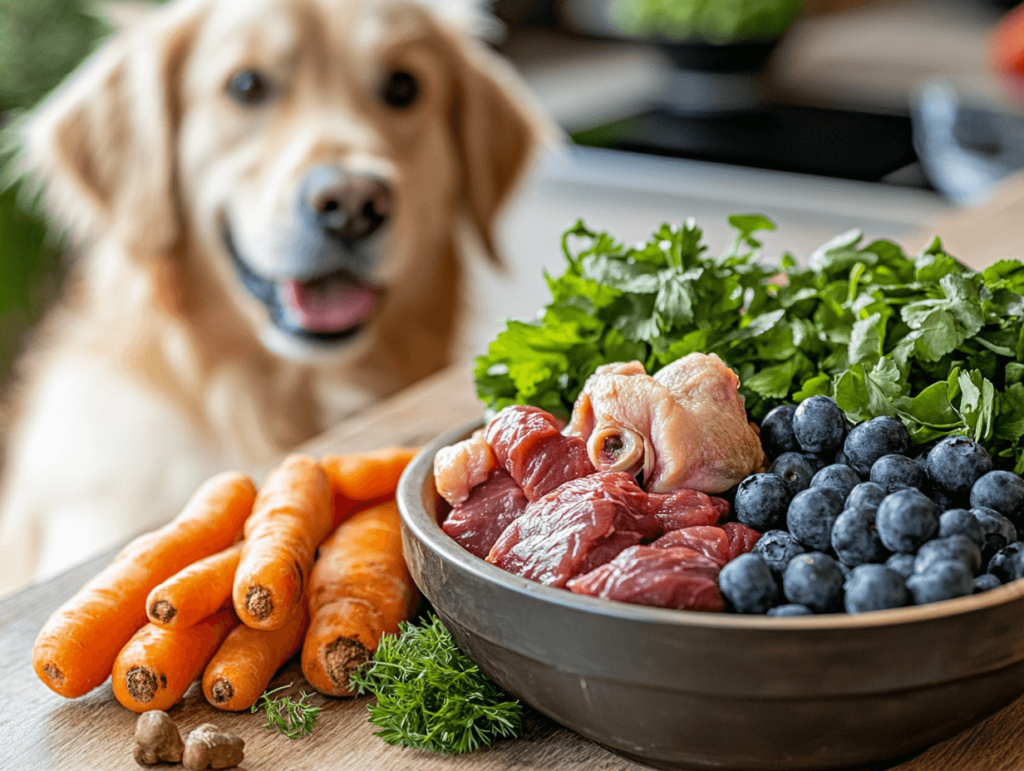
Introduction: Why Consider a Raw Diet for Your Dog?
Pet owners worldwide are becoming increasingly conscious of their dogs’ nutritional needs, leading many to explore raw dog food recipes as an alternative to kibble. this Raw Dog Food Recipe diet trend, often referred to as BARF (Biologically Appropriate Raw Food) or the Prey Model Raw Diet, is based on feeding dogs what their ancestors would have eaten in the wild—fresh, uncooked meats, bones, and organ meats.
The raw feeding movement gained popularity in the 1990s, thanks to veterinarians and animal nutritionists who argued that commercial dog food often contains preservatives, fillers, and artificial ingredients that may negatively impact canine health. However, before switching your dog to a raw diet, it’s essential to understand the benefits, risks, and proper meal preparation techniques.
If you’re new to raw feeding, check out this comprehensive guide to raw dog food, which covers everything from ingredient selection to food safety.
The Benefits of Raw Dog Food Diets
Advocates of raw feeding claim numerous health advantages, including:

1. Improved Digestion and Nutrient Absorption
Unlike kibble, which is often high in carbohydrates and artificial additives, raw food is easier for dogs to digest. This often results in:
- Smaller, firmer stools due to better nutrient absorption.
- Fewer digestive issues like bloating, gas, and diarrhea.
- Reduced allergy symptoms, as some commercial foods contain common allergens like wheat, soy, and corn.
2. Healthier Skin and Shinier Coat
Raw diets are rich in essential fatty acids, which contribute to:
- Reduced itching and dry skin.
- A shinier, softer coat.
- A decrease in skin infections or irritations.
3. Better Dental Health
Chewing on raw meaty bones helps to naturally clean your dog’s teeth, reducing:
- Plaque buildup.
- Gum disease.
- The need for professional dental cleanings.
4. Higher Energy Levels and Leaner Body Composition
Because raw food lacks excessive fillers, dogs often experience:
- More sustained energy levels.
- Improved muscle tone and joint health.
- Better weight management.
For an in-depth look at how a raw diet affects canine health, read this article on the benefits of raw feeding.
Potential Risks of Raw Feeding and How to Avoid Them
While the benefits are enticing, raw feeding does come with certain risks. Understanding these can help you make an informed decision.
1. Risk of Bacterial Contamination
Handling raw meat requires strict food safety protocols to prevent illnesses like Salmonella or E. coli. To mitigate this risk:
- Wash hands, surfaces, and utensils thoroughly after handling raw meat.
- Store raw dog food at safe temperatures (below 40°F/4°C).
- Thaw frozen meals safely in the fridge, not at room temperature.
2. Nutritional Imbalances
Feeding raw isn’t just about giving your dog raw meat. A properly balanced raw meal must include:
- Muscle meat (the base of the diet).
- Raw meaty bones (calcium and phosphorus source).
- Organ meats (liver, kidney, heart for essential vitamins).
- Fruits and vegetables (for fiber and micronutrients).
- Supplements if necessary (e.g., fish oil, kelp powder).
3. Choking Hazards and Bone Safety
- Only feed raw bones, never cooked bones (which can splinter).
- Choose bone sizes wisely, ensuring they match your dog’s chewing ability.
- Supervise meal times, especially in the beginning.
If you’re worried about nutritional deficiencies, here’s a guide on ensuring a balanced raw diet.
ey Ingredients for Raw Dog Food Recipes: What Should Be in a Raw Dog Food Recipe?
When preparing a raw meal, it’s crucial to select high-quality, fresh ingredients. Here’s a breakdown of what should go into your dog’s diet:
1. Proteins (50-80% of the diet)
- Chicken (breast, thighs, necks, wings)
- Beef (ground beef, steak, heart, liver)
- Turkey (drumsticks, wings, necks)
- Fish (sardines, salmon, mackerel)
- Lamb (shoulder, shank, kidney, liver)
2. Raw Meaty Bones (10-15%)
- Chicken wings, necks, and backs.
- Beef ribs or marrow bones.
- Turkey necks.
3. Organ Meats (10-15%)
- Liver (high in vitamin A).
- Kidneys (rich in essential minerals).
- Spleen, pancreas, and heart.
4. Vegetables and Fruits (Optional)
- Carrots, spinach, kale.
- Blueberries, apples (without seeds), bananas.
Easy Raw Dog Food Recipes for Beginners
Ingredients:
- 2 lbs ground beef
- 4 oz chicken liver
- 1/2 cup chopped carrots
- 1/2 cup spinach
- 1 whole egg (with shell)
- 1 tbsp fish oil
- 1/2 cup plain yogurt
Instructions:
- Chop the vegetables finely using a food processor.
- Mix all ingredients in a large bowl until well combined.
- Portion into meal-sized servings and store in the freezer.
- Thaw properly before feeding.
For more meal ideas, check out these homemade raw dog food recipes.
How to Transition Your Dog to a Raw Diet
Transitioning should be done gradually:
- Days 1-3: 25% raw, 75% kibble.
- Days 4-6: 50% raw, 50% kibble.
- Days 7-9: 75% raw, 25% kibble.
- Day 10+: 100% raw.
Monitor your dog for any digestive upset and adjust accordingly.
FAQs About Raw Feeding
1. Can I mix kibble with raw food?
It’s generally not recommended, as kibble digests at a different rate than raw food, which can cause stomach issues.
2. What supplements should I add?
- Fish oil for omega-3s.
- Kelp powder for trace minerals.
- Vitamin E for skin and coat health.
3. Is raw feeding expensive?
Raw feeding can be cost-effective if you buy in bulk and source from local butchers.
Final Thoughts: Is Raw Feeding Right for Your Dog?
Feeding your dog a raw diet can be highly beneficial, but it requires research, proper planning, and a commitment to food safety. If you’re considering switching, start with simple, balanced meals, monitor your dog’s response, and consult with your vet.For more resources, explore this comprehensive raw feeding guide.

